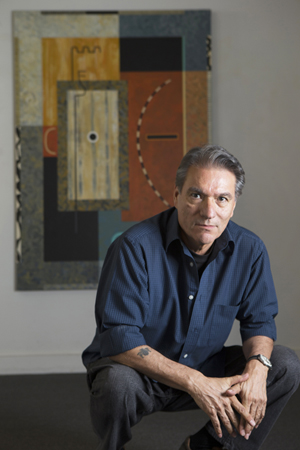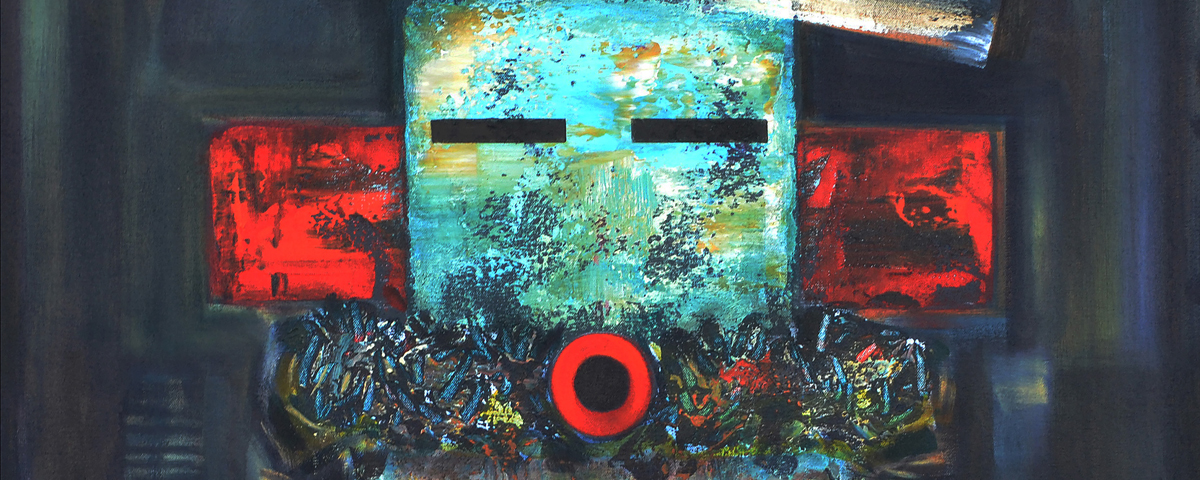
In his abstract work Harvest Tihu Dan Namingha depicts a traditional Hopi kachina doll, its carved wooden surface weathered with age, the tribal symbols reduced to a scattering of paint flakes. Yet like much of Namingha’s work, the 28-by-30-inch acrylic on canvas is contemporary, powerful and definitely personal.
“As a young person I used to carve those for ceremonies,” Namingha recalls during a recent interview at Niman Fine Art, his family gallery just off New Mexico’s historic Santa Fe Plaza. “Or sometimes my uncle would carve one, and he’d ask me to paint it. I’ve been working on this series since the early ’70s, and I still do it.”
Fact is, Namingha, 67, still does a lot of work—landscapes, mixed media, montages, collages, watercolors, oils, acrylics, even bronze and steel sculpture. “I jump around,” he admits.
Yet he never jumps far from his Hopi-Tewa heritage. “The landscape itself is sacred to the culture,” he says. “We are tapped into that. Whether I’m sculpting rock formations, and that becomes an abstract piece, it’s still a part of our existence.”
It’s all in the family at Niman Fine Art. Namingha’s wife, Frances, and daughter-in-law Nicole manage the gallery, which shows works by Dan and sons Arlo, a contemporary sculptor, and Michael, a mixed-media photographer. But the Naminghas’ artistic lineage stretches back even further. Dan’s great-great-grandmother Nampeyo (1856–1942) was among the finest Hopi-Tewa potters. Nampeyo’s daughters, Fannie Nampeyo and Annie Healing, followed in her footsteps, as did other family members.
Namingha’s grandparents reared him from infancy. His grandmother gave him clay when he was 5 or 6, and as his grandfather was a rancher, Dan sculpted horses and cows. “I never really got into ceramics,” he says. It was Namingha’s second-grade teacher who introduced Dan and his classmates to painting. A weekend painter herself, Lillian Russell saw something special in her students. “I think she noticed that a lot of the young native kids had this natural ability to draw and depict daily life and what interested them on the reservation,” Namingha says. So Russell turned a vacant sandstone building into a studio for the children.
“That’s where I spent much of my time,” he says, “and this class was usually before all our academic courses began in the morning. That was my motivation to wake up very early and get down to the school and work with all these materials that were provided. She basically showed us the technical aspects, and what we wanted to do was left up to us. So that was really my beginning.”
That led Namingha to a summer scholarship at the University of Kansas in Lawrence and then to the Institute of American Indian Arts in Santa Fe. Impressed with his illustration skills, an instructor there recommended him to the American Academy of Art in Chicago, and Namingha spent more time developing his technique at the Art Institute of Chicago. “I started looking at other work that was very contemporary,” he says. “My view of realism started shifting. I always wondered where else I could take it. Even today I go back and forth. The landscapes are very impressionistic and semiabstract, and some go into pure abstraction.”
Like his great-great-grandmother, Namingha has earned international renown. His works hang in museums and embassies worldwide, and he has participated in projects for such clients as Smithsonian and NASA. Last year he was named featured artist at the Museum of Indian Arts & Culture and living treasure of the Native Treasures Indian Arts Festival in Santa Fe. This year, on August 19 and 20, Niman Fine Art holds its annual exhibition in conjunction with the 96th Santa Fe Indian Market, the world’s largest juried American Indian art show.
Namingha has no intention of slowing down. When asked what’s next for him, he happily answers, “Just work—a lot of work.” WW





